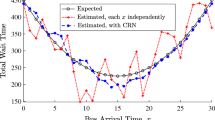Abstract
The hit and run methods are probabilistic algorithms that can be used to detect necessary (nonredundant) constraints in systems of linear constraints. These methods construct random sequences of lines that pass through the feasible region. These lines intersect the boundary of the region at twohit-points, each identifying a necessary constraint. In order to study the statistical performance of such methods it is assumed that the probabilities of hitting particular constraints are the same for every iteration. An indication of the best case performance of these methods can be determined by minimizing, with respect to the hit probabilities, the expected value of the number of iterations required to detect all necessary constraints. We give a set of isolated strong local minimizers and prove that for two, three and four necessary constraints the set of local minimizers is the complete set of global minimizers. We conjecture that this is also the case for any number of necessary constraints. The results in this paper also apply to sampling problems (e.g., balls from an urn) and to the coupon collector's problem.
Similar content being viewed by others
References
M. Abramowitz and I.A. Stegun, eds.,Handbook of Mathematical Functions (National Bureau of Standards, Washington, DC, 1964).
H.C.P. Berbee, C.G.E. Boender, A.H.G. Rinnooy Kan, C.L. Scheffer, R.L. Smith and J. Telgen, “Hit-and-run algorithms for the identification of nonredundant linear equalities,”Mathematical Programming 37 (1987) 184–207.
C.G.E. Boender, R.J. Caron, J.F. McDonald, A.H.G. Rinnooy Kan, H.E. Romeijn, R.J. Smith, J. Telgen and A.C.F. Vorst, “Shake-and-bake algorithms for generating uniform points on the boundary of bounded polyhedra,”Operations Research 39 (1991).
A. Boneh, “PREDUCE — A probabilistic algorithm for identifying redundancy by a random feasible point generator,” in: Karwan et al., eds.,Redundancy in Mathematical Programming (Springer, Berlin, 1983) pp. 108–134.
A. Boneh and A. Golan, “Constraints redundancy and feasible region boundedness by a random feasible point generator (RFPG),” contributed paper, EURO III, Amsterdam, April 1979.
A Boneh and H. Hofri, “The coupon collector's problem revisited,” Technical Report, The Technion (Haifa, Israel, 1989).
R.J. Caron and J.F. McDonald, “A new approach to the analysis of random methods for detecting necessary linear inequality constraints”,Mathematical Programming 43 (1989) 97–102.
R.J. Caron, M. Hlynka and J.F. McDonald, “On the best case performance of probabilistic methods for detecting necessary constraints,” Windsor Mathematics Report WMR 88-02, Department of Mathematics and Statistics, University of Windsor (Windsor, Ont., Canada, 1988).
R.J. Caron, J.F. McDonald, R.L. Smith and J. Telgen, “Random methods for detecting necessary linear inequality constraints: Stopping rules,” Windsor Mathematics Report WMR 86-03, Department of Mathematics and Statistics, University of Windsor (Windsor, Ont., 1986).
W. Feller,An Introduction to Probability Theory and its Applications, Vol. 1 (Wiley, New York, 1968).
M.H. Karwan, V. Lotfi, J. Telgen and S. Zionts, eds.,Redundancy in Mathematical Programming (Springer, Berlin, 1983).
R.L. Smith and J. Telgen, “Random methods for identifying nonredundant constraints,” Technical Report 81-4, Department of Industrial and Operations Engineering, The University of Michigan (Ann Arbor, MI, 1981).
M. Sobel, “Multinomial problems in geometric probability with Dirichlet analysis,” Technical Report No. 239, Department of Statistics, Stanford University (Stanford, CA, 1987).
J. Telgen, private communication with A. Boneh (January 1980).
Author information
Authors and Affiliations
Rights and permissions
About this article
Cite this article
Caron, R.J., Hlynka, M. & McDonald, J.F. On the best case performance of hit and run methods for detecting necessary constraints. Mathematical Programming 54, 233–249 (1992). https://doi.org/10.1007/BF01586052
Received:
Revised:
Issue Date:
DOI: https://doi.org/10.1007/BF01586052




